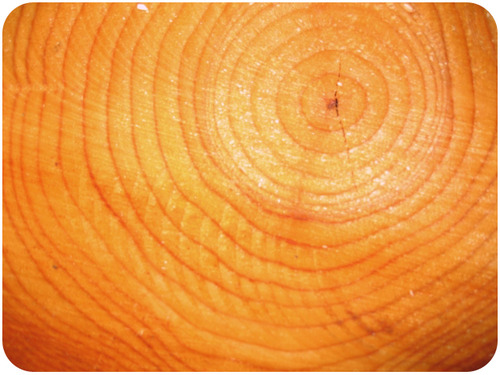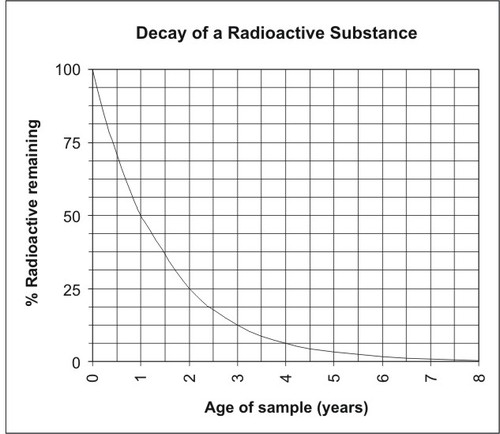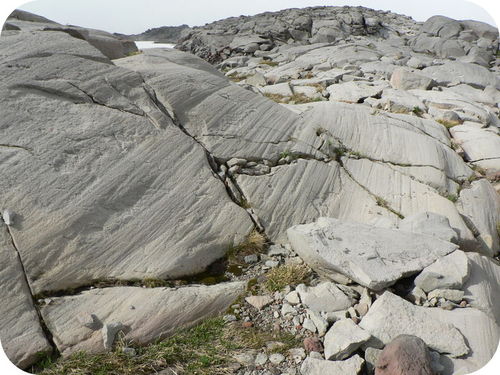Vocabulary
differentiation
outgassing
paleontologist
Introduction
Historical geologists study Earth’s past to understand what happened and when it happened. Paleontologists do the same thing, but with an emphasis on the history of life, especially as it is understood from fossils. Despite having very little material from those days, scientists have many ways of learning about the early Earth.
Formation of Earth
Earth came together (accreted) from the cloud of dust and gas known as the solar nebula nearly 4.6 billion years ago, the same time the Sun and the rest of the solar system formed. Gravity caused small bodies of rock and metal orbiting the proto-Sun to smash together to create larger bodies. Over time, the planetoids got larger and larger until they became planets. More information about planet formation is in the chapter about the solar system.
There is little hard evidence for scientists to study from Earth’s earliest days. Much of what scientists know about the early Earth come from three sources: (1) zircon crystals, the oldest materials found on Earth, which show that the age of the earliest crust formed at least 4.4 billion years ago; (2) meteorites that date from the beginning of the solar system, to nearly 4.6 billion years ago (Figurebelow); and (3) lunar rocks, which represent the early days of the Earth-Moon system as far back as 4.5 billion years ago.
[Figure 1]
The Allende Meteorite is a carbonaceous chondrite that struck Earth in 1969. The calcium-aluminum-rich inclusions are fragments of the earliest solar system.
Molten Earth
When Earth first came together it was really hot, hot enough to melt the metal elements that it contained. Why was the early Earth so hot?
Gravitational contraction: As small bodies of rock and metal accreted, the planet grew larger and more massive. Gravity within such an enormous body squeezes the material in its interior so hard that the pressure swells. As Earth’s internal pressure grew, its temperature also rose.
Radioactive decay: Radioactive decay releases heat, and early in the planet’s history there were many radioactive elements with short half lives. These elements long ago decayed into stable materials, but they were responsible for the release of enormous amounts of heat in the beginning.
Bombardment: Ancient impact craters found on the Moon and inner planets indicate that asteroid impacts were common in the early solar system. Earth was struck so much in its first 500 million years that the heat was intense. Very few large objects have struck the planet in the past many hundreds of millions of year.
Differentiation
When Earth was entirely molten, gravity drew denser elements to the center and lighter elements rose to the surface. The separation of Earth into layers based on density is known as differentiation. The densest material moved to the center to create the planet’s dense metallic core. Materials that are intermediate in density became part of the mantle (Figurebelow).
[Figure 2]
Earth’s interior: Inner core, outer core, mantle, and crust.
Lighter materials accumulated at the surface of the mantle to become the earliest crust. The first crust was probably basaltic, like the oceanic crust is today. Intense heat from the early core drove rapid and vigorous mantle convection so that crust quickly recycled into the mantle. The recycling of basaltic crust was so effective that no remnants of it are found today.
How the Moon Formed
One of the most unique features of planet Earth is its large Moon. Unlike the only other natural satellites orbiting an inner planet, those of Mars, the Moon is not a captured asteroid. Understanding the Moon’s birth and early history reveals a great deal about Earth’s early days.
To determine how the Moon formed, scientists had to account for several lines of evidence:
The Moon is large; not much smaller than the smallest planet, Mercury.
Earth and Moon are very similar in composition.
Moon’s surface is 4.5 billion years old, about the same as the age of the solar system.
For a body its size and distance from the Sun, the Moon has very little core; Earth has a fairly large core.
The oxygen isotope ratios of Earth and Moon indicate that they originated in the same part of the solar system.
Earth has a faster spin than it should have for a planet of its size and distance from the Sun.
Can you devise a “birth story” for the Moon that takes all of these bits of data into account?
Astronomers have carried out computer simulations that are consistent with these facts and have detailed a birth story for the Moon. A little more than 4.5 billion years ago, roughly 70 million years after Earth formed, planetary bodies were being pummeled by asteroids and planetoids of all kinds. Earth was struck by a Mars-sized asteroid (Figure below).
[Figure 3]
An artist’s depiction of the impact that produced the Moon.
The tremendous energy from the impact melted both bodies. The molten material mixed up. The dense metals remained on Earth but some of the molten, rocky material was flung into an orbit around Earth. It eventually accreted into a single body, the Moon. Since both planetary bodies were molten, material could differentiate out of the magma ocean into core, mantle, and crust as they cooled. Earth’s fast spin is from energy imparted to it by the impact.
[Figure 4]
The Genesis Rock was brought back to Earth by the Apollo 15 astronauts.
Lunar rocks reveal an enormous amount about Earth’s early days. The Genesis Rock, with a date of 4.5 billion years, is only about 100 million years younger than the solar system (Figure above). The rock is a piece of the Moon’s anorthosite crust, which was the original crust. Why do you think Moon rocks contain information that is not available from Earth’s own materials?
Can you find how all of the evidence presented in the bullet points above is present in the Moon’s birth story?
Earth's Early Atmosphere and Oceans
At first, Earth did not have an atmosphere or free water since the planet was too hot for gases and water to collect. The atmosphere and oceans that we see today evolved over time.
Earth’s First Atmosphere
Earth’s first atmosphere was made of hydrogen and helium, the gases that were common in this region of the solar system as it was forming. Most of these gases were drawn into the center of the solar nebula to form the Sun. When Earth was new and very small, the solar wind blew off atmospheric gases that collected. If gases did collect, they were vaporized by impacts, especially from the impact that brought about the formation of the Moon.
Eventually things started to settle down and gases began to collect. High heat in Earth’s early days meant that there were constant volcanic eruptions, which released gases from the mantle into the atmosphere (Figure below). Just as today, volcanic outgassing was a source of water vapor, carbon dioxide, small amounts of nitrogen, and other gases.
[Figure 5]
Nearly constant volcanic eruptions supplied gases for Earth’s early atmosphere.
Scientists have calculated that the amount of gas that collected to form the early atmosphere could not have come entirely from volcanic eruptions. Frequent impacts by asteroids and comets brought in gases and ices, including water, carbon dioxide, methane, ammonia, nitrogen, and other volatiles from elsewhere in the solar system (Figure below).
[Figure 6]
The gases that create a comet’s tail can become part of the atmosphere of a planet.
Calculations also show that asteroids and comets cannot be responsible for all of the gases of the early atmosphere, so both impacts and outgassing were needed.
Earth’s Second Atmosphere
The second atmosphere, which was the first to stay with the planet, formed from volcanic outgassing and comet ices. This atmosphere had lots of water vapor, carbon dioxide, nitrogen, and methane but almost no oxygen. Why was there so little oxygen? Plants produce oxygen when they photosynthesize but life had not yet begun or had not yet developed photosynthesis. In the early atmosphere, oxygen only appeared when sunlight split water molecules into hydrogen and oxygen and the oxygen accumulated in the atmosphere.
Without oxygen, life was restricted to tiny simple organisms. Why is oxygen essential for most life on Earth?
1. Oxygen is needed to make ozone, a molecule made of three oxygen ions, O3. Ozone collects in the atmospheric ozone layer and blocks harmful ultraviolet radiation from the Sun. Without an ozone layer, life in the early Earth was almost impossible.
2. Animals need oxygen to breathe. No animals would have been able to breathe in Earth’s early atmosphere.
Early Oceans
The early atmosphere was rich in water vapor from volcanic eruptions and comets. When Earth was cool enough, water vapor condensed and rain began to fall. The water cycle began. Over millions of years enough precipitation collected that the first oceans could have formed as early as 4.2 to 4.4 billion years ago. Dissolved minerals carried by stream runoff made the early oceans salty. What geological evidence could there be for the presence of an early ocean? Marine sedimentary rocks can be dated back about 4 billion years. By the Archean, the planet was covered with oceans and the atmosphere was full of water vapor, carbon dioxide, nitrogen, and smaller amounts of other gases.
Lesson Summary
Earth and the other planets in the solar system formed about 4.6 billion years ago.
The early Earth was frequently hit with asteroids and comets. There were also frequent volcanic eruptions. Both were sources of water and gases for the atmosphere
The early Earth had no ozone layer, no free oxygen, and was very hot.
The oceans originally formed as water vapor released by volcanic outgassing and comet impacts cooled and condensed.
Earth was struck by a giant impactor, which flung material out into orbit around the planet. This material accreted into Earth’s only natural satellite, the Moon.
















































